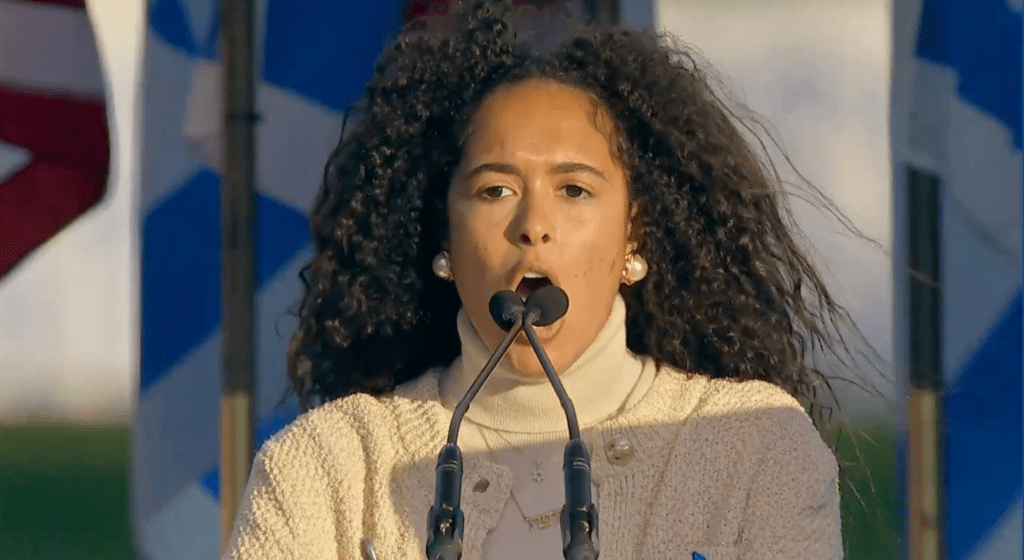Introduction
In the heart of Washington, D.C., on November 14, 2023, history unfolded as the National Mall became the epicenter of a monumental pro-Israel demonstration – the March for Israel. Organized by the Conference of Presidents of Major American Jewish Organizations and the Jewish Federations of North America, this rally marked a powerful expression of solidarity with Israel during the challenging times of the 2023 Israel–Hamas war. With the rallying cry of “Never Again” echoing through the air, nearly 300,000 participants gathered to send a resounding message of support for Israel, demand the release of hostages held by Hamas, and condemn the alarming rise of antisemitism.
A Response to Ongoing Conflict
The backdrop of the 2023 Israel–Hamas war, characterized by heightened tensions and violence, set the stage for the March for Israel. As the conflict unfolded, the world witnessed numerous protests, demonstrations, and vigils globally. The March for Israel emerged as a significant event within this broader context, seeking to address the multifaceted issues arising from the ongoing conflict.
Objectives of the Rally
The rally’s three primary objectives, as outlined by the March For Israel website, reflected the urgency and gravity of the situation. First and foremost, it aimed to demonstrate unwavering support for Israel, a nation grappling with the challenges posed by the Israel–Hamas war. Secondly, the rally called for the release of more than 240 hostages held by Hamas, a poignant plea echoing since the October 7 Hamas attack on Israel. Lastly, the event aimed to tackle the disturbing surge in antisemitism following the onset of hostilities. The Anti-Defamation League’s report of a 388% increase in antisemitic incidents in the U.S. since October 6, 2023, underscored the critical need for collective action.

Unprecedented Turnout
The March for Israel witnessed an unprecedented turnout, with an estimated 290,000 people converging on the National Mall. This massive assembly not only demonstrated the magnitude of U.S. support for Israel but also earned the distinction of being labeled the “largest pro-Israel gathering in history.” The Homeland Security Department designated the event as a “level 1” security event, attesting to its significance and necessitating substantial law enforcement assistance from federal agencies.

Diverse Representation
The diverse representation at the march was emblematic of a united front in support of Israel. Attendees, organized by various Jewish communities, arrived in Washington from New York, New Jersey, Los Angeles, Houston, Miami, Boston, Kansas City, Philadelphia, Birmingham, Alabama, and other domestic and international locations. Notably, the inclusion of Sephardic U, represented by Sam Bendayan, added a distinct and diverse voice to the chorus of solidarity.
Voices of Unity: Speakers and Performers
The rally featured a lineup of influential speakers, including Senate Majority Leader Chuck Schumer, House Speaker Mike Johnson, House Minority Leader Hakeem Jeffries, Senator Joni Ernst, televangelist John Hagee, Israeli President Isaac Herzog (via video from Jerusalem), and U.S. envoy on antisemitism Deborah Lipstadt. The diverse range of speakers, which included Natan Sharansky, actress Debra Messing, and family members of hostages kidnapped by Hamas, aimed to bridge political divisions and foster bipartisan support.
Musical performances added a vibrant dimension to the event, featuring artists such as Ishay Ribo, Omer Adam, Matisyahu, and the acapella group The Maccabeats. The renditions, especially Matisyahu and The Maccabeats‘ performance of “One Day,” resonated with the crowd, amplifying the message of hope and unity.
Addressing Criticism
While the March for Israel garnered widespread support, it did not escape criticism. The Jewish advocacy group IfNotNow labeled the march as a “pro-war, pro-Nakba rally.” Additionally, concerns were raised about John Hagee’s participation, given past controversial statements. Such criticisms highlight the challenges of navigating diverse perspectives within the broader pro-Israel movement.
International Coverage: A Global Statement
The March for Israel not only captivated the attention of those present but also made headlines globally. The Times of Israel reported on the event under the headline “‘Let our people go’: Nearly 300,000 rally in Washington for Israel, hostages’ release.” The report emphasized the historic nature of the gathering and underscored the rally’s call for the release of hostages and its condemnation of antisemitism.
Powerful Testimonials: Voices from the Rally
The rally provided a platform for the relatives of the hostages to share their stories and advocate for the release of their loved ones. Rachel Goldberg, whose son Hersh Goldberg-Polin was among those taken hostage, delivered a poignant address, describing the families’ agonizing 39 days of slow-motion torment. Other speakers, including Orna Neutra and Alana Zeitchik, shared personal stories, emphasizing the human cost of the conflict.

Columbia University student Noa Fay delivered a fiery speech, highlighting the challenges faced by Jewish students on college campuses and proclaiming, “I am a Black, Native American Jewish American woman, and I will not be silenced.”

Political Support and Critique
Prominent political figures, including Senate Majority Leader Chuck Schumer and House Speaker Mike Johnson, addressed the crowd, emphasizing the historical persecution of the Jewish people and asserting the moral case for Israel. Schumer’s declaration, “When Hamas says from the river to the sea, they mean all the present-day Israel should be a Jewish-free land,” resonated with the audience. However, critiques were voiced over the inclusion of controversial figures like John Hagee, showcasing the complexity of aligning diverse voices within the pro-Israel movement.
Conclusion: A Defining Moment
The March for Israel in 2023 was undeniably a defining moment in the history of pro-Israel demonstrations. It brought together a diverse and passionate coalition, united by a shared commitment to supporting Israel, advocating for the release of hostages, and combating antisemitism. While facing criticism and navigating internal divisions, the march succeeded in making a global statement, reinforcing the enduring bond between the United States and Israel in times of adversity. As the echoes of “Never Again” reverberated through the National Mall, the March for Israel stood as a testament to the resilience, unity, and unwavering support for a nation facing profound challenges.








Ohr HaChaim Yomi – Emor